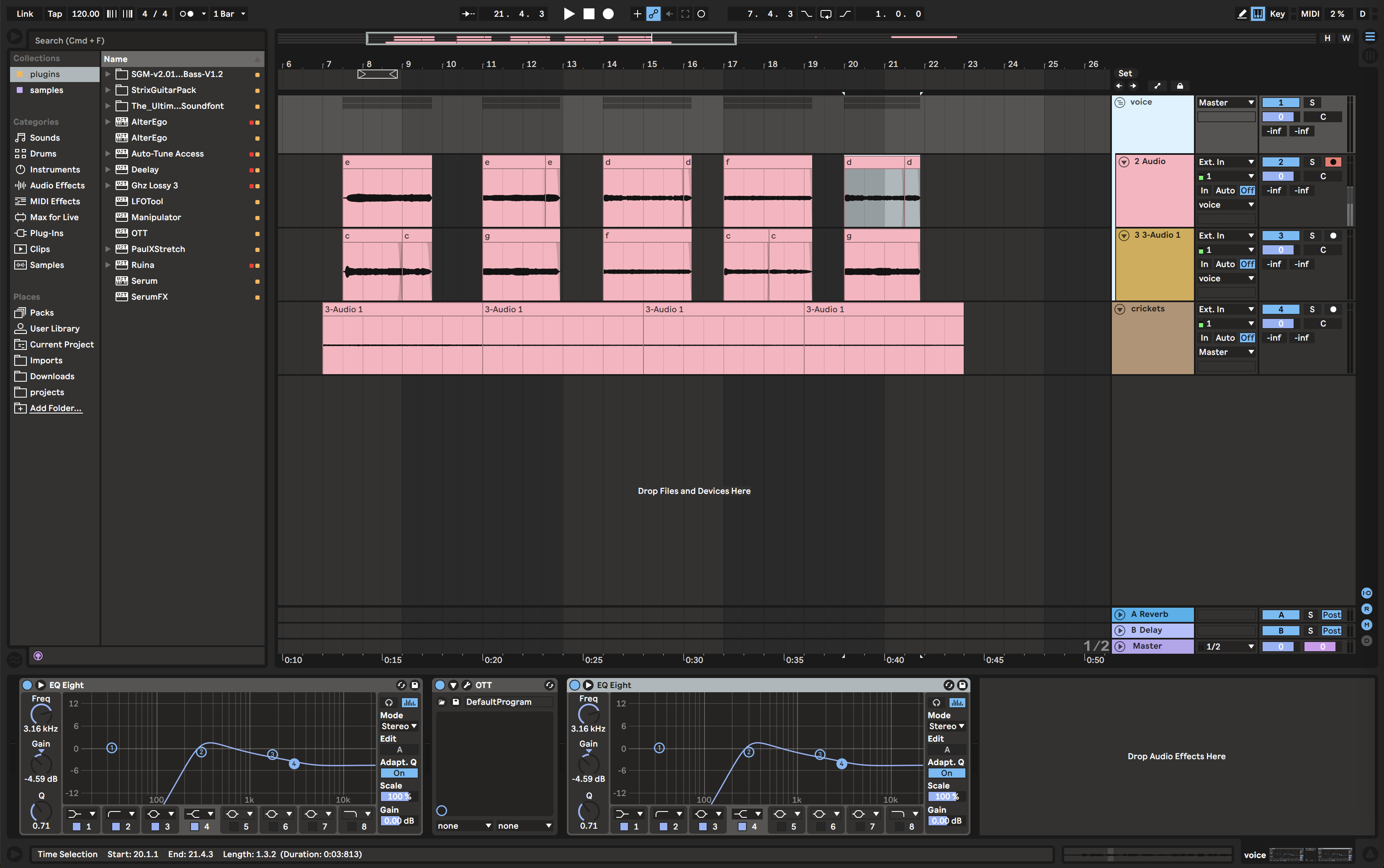inspiration
how to hack a painting 
i love how tyler hobbs breaks down a single watercolor stroke into its component parts. his walkthrough made it really simple to implement the data structures i needed to build this effect from scratch.
implementation

geometry
getting everything to work in p5 would've been painful, so instead a wrote a typescript app to draw directly to the canvas. this made debugging much easier.
visually, my design is a port of hobbs' work in typescript, with added animation code. the algorithm that hobbs describes basically takes a polygon and extrudes the midpoints of each of its sides. it does this recursively, decreasing the opacity and the amount of extrusion on each pass. with some random variation, this technique produces an effect that looks surprisingly natural.
to start, i added two data structures to define a 2d vector and a polygon:
export interface Vector2D {
x: number;
y: number;
}
export interface Polygon {
sides: number;
size: number;
center: Vector2D;
}then i wrote a function to get the on-screen coordinates for every point in a polygon:
export const getPoints = (polygon: Polygon) => {
const points: Vector2D[] = [];
// Push the rightmost point of the polygon to the points array
points.push({
x: polygon.center.x + polygon.size * Math.cos(0),
y: polygon.center.y + polygon.size * Math.sin(0),
});
// Rotate around the center to get the coordinate of every other point
// and add it to the array
for (let i = 1; i <= polygon.sides; i++) {
const point: Vector2D = {
x: Math.round(
polygon.center.x +
polygon.size * Math.cos((i * 2 * Math.PI) / polygon.sides),
),
y: Math.round(
polygon.center.y +
polygon.size * Math.sin((i * 2 * Math.PI) / polygon.sides),
),
};
points.push(point);
}
return points;
};and a function to extrude the midpoints of each side of a polygon by a given factor:
export const extrudeMidpoints = (points: Vector2D[], factor: number) => {
let extrudedPoints: Vector2D[] = [];
// Add a midpoint to the points array for each side of the polygon
points = subdivide(points);
for (let i = 0; i < points.length; i++) {
// Every other point will be a midpoint, so let's only look at those
if (i % 2 != 0) {
const point = points[i];
// Find the vector perpendicular to this side
const startPoint = points[i - 1];
const endPoint = points[(i + 1) % points.length];
const normalVector = calculateNormal(startPoint, endPoint);
// Extrude the midpoint along that vector by the factor
// randn_bm() returns a normal distribution,
// helps make things look more organic
const extrudedPoint: Vector2D = {
x: point.x + normalVector.x * factor * randn_bm(),
y: point.y + normalVector.y * factor * randn_bm(),
};
extrudedPoints.push(extrudedPoint);
} else {
extrudedPoints.push(points[i]);
}
}
return extrudedPoints;
};to render the effect to the canvas, this function takes a polygon and a color, then recursively calls the extrusion function, which makes a blotchy shape. it then further distorts that shape 50 times, drawing it with lower opacity and a random delay each time:
const blotch = (polygon: Polygon, color: string) => {
// Start with a distorted polygon
const basePolygon = extrudeMidpoints(
extrudeMidpoints(extrudeMidpoints(getPoints(polygon), 60), 20),
10,
);
// Draw 50 times, distorting it further in a fractal
let counter = 50;
const recursiveDraw = () => {
drawPoints(
extrudeMidpoints(
extrudeMidpoints(extrudeMidpoints(basePolygon, 10), 8),
5,
),
ctx,
color,
);
// Until this function has been called 50 times, call it again
if (counter > 0) {
counter--;
window.setTimeout(
recursiveDraw,
// Wait about 15ms, with some variation
Math.random() * (20 - 20 / counter) + 20 / counter,
);
}
};
recursiveDraw();
};then we call that function whenever the mouse is held down:
export const onMouseMove = (ev: MouseEvent) => {
// Create a decagon with a random size at the mouse position
const polygon: Polygon = {
size: Math.random() * (100 - 50) + 50,
sides: 10,
center: {
x: ev.clientX,
y: ev.clientY,
},
};
// If the mouse is down and over the canvas,
// draw the blotch after a short delay
if (mouseDown && hovered) {
sleep(25).then(() => {
blotch(polygon);
});
}
};audio
i recorded the audio on my laptop mic and did some eq'ing and compression in ableton, then stacked the samples into harmonies. (the crickets were in the background, i thought they made a nice addition)

then i exported the samples as wav's and imported them into Tone:
// Start crickets loop as soon as audio is ready
const crickets = new Tone.Player({
url: "/crickets.wav",
autostart: true,
loop: true,
volume: 1,
}).toDestination();
// Add some reverb
const reverb = new Tone.Reverb(2);
// Load all of our samples
const players = new Tone.Players(
{
a: "/a.wav",
s: "/s.wav",
d: "/d.wav",
f: "/f.wav",
g: "/g.wav",
},
{ fadeIn: 2, fadeOut: 0.5, volume: 20 },
).chain(reverb, Tone.Destination);
// Start the sketch with the first sample ready to play
let selectedPlayer = players.player("a");then Tone listens for the user to click the canvas and press a key, and plays audio and changes the sample accordingly:
let started = false;
let painting = false;
// The first time the user clicks the canvas, start Tone,
// then play the active sample
export const onMouseDown = async (ev: MouseEvent) => {
if (hovered) {
if (!started) {
await Tone.start().then(() => (started = true));
}
painting = true;
selectedPlayer.start();
selectedPlayer.loop = true;
}
};
// Stop all audio when the user stops painting
export const onMouseUp = (ev: MouseEvent) => {
players.stopAll();
painting = false;
};
// A switch statement to change the active sample when a key is pressed
export const onKeyDown = (ev: KeyboardEvent) => {
switch (ev.key) {
case "a":
selectedPlayer.stop();
selectedPlayer = players.player("a");
if (painting) selectedPlayer.start();
break;
case "s":
selectedPlayer.stop();
selectedPlayer = players.player("s");
if (painting) selectedPlayer.start();
break;
case "d":
selectedPlayer.stop();
selectedPlayer = players.player("d");
if (painting) selectedPlayer.start();
break;
case "f":
selectedPlayer.stop();
selectedPlayer = players.player("f");
if (painting) selectedPlayer.start();
break;
case "g":
selectedPlayer.stop();
selectedPlayer = players.player("g");
if (painting) selectedPlayer.start();
break;
default:
break;
}
};